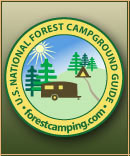Grassland Information
The Cimarron National Grassland (NG), located in the southwest corner of Kansas, is comprised of 108,175 acres. Overall administration is provided by the Pike and San Isabel National Forests supervisor office, Rocky Mountain Region. There is one developed campground meeting the selection criteria.
The grassland holds the distinction of being the largest parcel of public land in the state of Kansas. Visitors to the Cimarron NG can enjoy hiking, fishing, hunting, camping, bird watching and leisure scenic drive opportunities. Like other national grasslands, the Cimarron is a patchwork of public and private land and is a legacy of the 1930s Dust Bowl era.
The Cimarron NG was settled in the 1800s under a variety of "Homestead Acts," which opened the land to people, generally farmers, and helped to settle the west. A prolonged period of drought in the late 1920s into the 1930s caused some homesteads on sub-marginal farmland (a location receiving 15 or less inches of annual moisture) to literally dry up. During this time, Congress established the Land Utilization Program (LUP) which bought homesteads from bankrupt private owners and returned it to public land status. In the 1950s, the LUP holdings were assigned to the USDA Forest Service who was tasked with management of these sub-marginal lands. Over the years the Forest Service has established some twenty National Grasslands, including Cimarron, from sub-marginal lands. "The designation of the area as National Grassland is not a description of the area as much as a statement of policy and effort to restore the area to a multiple of uses and benefits."
The success of the Forest Service's efforts can be seen in the agriculture efforts in and around the grassland. It is hard to imagine this area was the heart of the Dust Bowl and towering billowing clouds of dust were a daily occurrence. Photographs from the period document the results of those earlier incorrect agriculture practices. The wind still blows across the grassland but the land stays put, giving testimony that the agriculture practices advocated by the Forest Service have helped the land recover.
One indication of a grassland's success is the population of Lesser prairie-chicken found on the Cimarron. The loss of "sandsage prairie" to crop land had a serious impact on the bird's population. Dependent on rangeland, a.k.a. "sandsage prairie" for nesting, brood rearing, and food, the Cimarron is continuing to aid this unique grassland bird's recovery. There are blinds available to the public to observe the Lesser prairie-chicken's displays in the early Spring. (Contact the Cimarron for more details.)
Between 1821 and 1846, the Santa Fe Trail was a primary trade route between America and Mexico. A 23-mile segment, the longest on public land, crosses the Cimarron. A mowed "companion" swath parallels the Trail and provides visitors on foot or horseback the opportunity to experience this piece of living history.
A good way to experience the Cimarron is via The Sea of Grass Auto Tour. It winds through the grassland and gives visitors an overview of the grasslands history and attractions. The Cimarron River may be the center piece of this tour but don't expect to see something more than a slow moving creek, and that would occur only in a wet year. The tour has stops at such locations as the "Miracle" well, Pioneer Memorial, Middle Spring, and a couple of gas development sites. This is a nice day trip from the grassland's only developed campground, Cimarron Recreation Area.
Cimarron does permits dispersed camping anywhere on the grassland except in developed areas such as trail heads and picnic areas. However, Cimarron Recreation Area offers campers amenities not available to the dispersed camper. Wheelchair-friendly toilets, drinking water, and level parking aprons are just a few of the amenities available. The campground features several small ponds, stocked with catfish in the summer months and Rainbow trout during the winter. The ponds are used for the annual Fishing Derby held in conjunction with the Grassland Heritage Festival in June.
The 30-mile Sea of Grass Auto Tour (see brochure and map) also provides visitors with a glimpse of where cattle graze on the Cimarron. Under a permit system, approximately 5,200 head of cattle use the Cimarron to supplement their home pastures. This system helps about 100 area ranchers maintain the condition of their land and herd and assist the Forest Service in maintaining the grassland's vegetation.
Gas and oil development are part of the balancing act the Forest Service on the Cimarron NG must oversee. There might be approximately 450 oil/gas facilities and maybe 500 miles of pipeline on the grassland.
The Cimarron has the typical grassland wildlife such as Pronghorn, Prairie dogs, Lesser prairie chickens, Mule deer, Wild turkey, Golden eagle, Swift fox and many species of birds. However, the grassland's small head of Elk is the "pride of Kansas" and a source of wonder to many grassland visitors. It is a lucky visitor who will spot one of these magnificent creatures.
The Cimarron National Grassland isn't the biggest grassland nor the most diverse but it is special. It has survived the devastation caused by misguided farming practices, overgrazing, and the Dust Bowl to be a little oasis of green in the southwest corner of Kansas, just waiting for people to discover what it has to offer.
ADDRESSES
SUPERVISOR ADDRESS
2840 Kachina Drive
Pueblo, Colorado 81008
719-553-1400
RANGER DISTRICT ADDRESS
Cimarron
242 East Highway 56
P.O. Box 300
Elkhart, Kansas 67950
620-697-4621 |
